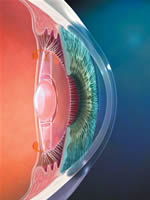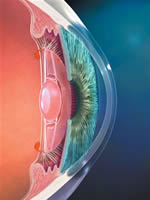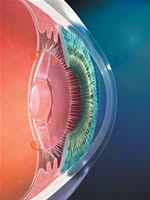 |
|
| Home | LASIK | Procedures | Comprehensive Eye Care | Cosmetics | About | Contact |

|
|||||||
Cataract SurgeryWhat is a Cataract?
People with progressed cataracts often describe the sensation as looking through a piece of cloudy cellophane. A cataract may make light from the sun or a lamp seem too bright, causing glare. Colors may not appear as bright as they once did, however, most cataracts develop so slowly that people usually don’t realize that their color vision has markedly deteriorated. Oncoming headlights may cause uncomfortable glare at night, making driving more difficult. Causes of Cataracts
Symptoms
Cataract SurgeryCataracts are removed using a no stitch, no needle small incision surgery known as phaecoemulsification. After application of a topical anesthetic an incision of 2.5 to 3 millimeters in length is then created at the junction of the cornea (the clear domed structure on the front of the eye) and the sclera (the white part of the eye). The cataract is then broken using an ultrasonic device and suctioned from the eye.    Once all of the cataract material has been removed, a folded intraocular lens is inserted through the original incision. The lens is then maneuvered into the lens capsule and centered. The lens will remain inside your eye in this location. Intraocular lenses cannot be felt or sensed in any way by the patient. Intraocular Lens OptionsIntraocular lens come in a variety of materials and designs. Your surgeon generally chooses a lens made of a material that is best suited to your individual situation. All intraocular lenses used in our practice are coated with UV filters. Some lenses are yellow in color. These lenses are theoretically better at blocking the light rays in the blue spectrum which are thought to be related to the development of macular degeneration in some patients. Some intraocular lenses are designed to be multifocal in certain lighting circumstances, which may enable patients to see both at distance and near without the aid of spectacles? The Crystalens is also an option and is commonly referred to as the accomodating lens or also a presbyopic correcting IOL option. If you are seeking cataract surgery in Philadelphia or the southern New Jersey region please feel free to consult us directly regarding these new Intraocular lens options. This decision could play a major role in the quality of your lifestyle as you begin to age. Our doctors have the technology and expertise to provide you with the best possible visual outcome. | |||||||
Glaucoma ProceduresHow is glaucoma treated?Glaucoma treatment is aimed at controlling the eye's fluid pressure, as a means of slowing the disease's progression. Such treatment does not cure the disease. Most doctors use medications for newly diagnosed glaucoma; however, new research findings show that laser surgery is a safe and effective alternative.
About the mechanisms of aqueous humor inflow and outflow, glaucomatous tissue changes in the optic nerve, and the dynamics of trabecular meshwork cells. | |||||||
Keratoconus (INTACS)INTACS is a new and novel treatment for Keratoconus. It is a minimally invasive office procedure which can greatly improve vision without much risk. INTACS work by flattening the cornea. See animation. Click here to see an actual insertion of INTACS. Click here for a video discussing INTACS for keratoconus by some world experts | |||||||
Diabetes and The EyeDiabetes and Your EyesIf you are a diabetic patient you are most likely aware of many dangers related to your health but have you discussed the implications of this disease with an eye care professional. The doctors at IC Laser have extensive training for diagnosing and treating patients that may suffer from degenerative symptoms related to diabetes. We suggest regular eye examinations to determine actual health of your eye. We hope to detect any early developments of diabetic retinopathy, retinal tears, or even macular degeneration in order to ensure quick and effective treatment. Keeping blood sugars relatively normal is the best known way to keep your eyes healthy and safe from the possible dangers of retinal problems. Approximately 16 million Americans have diabetes today. Many of these patients living with diabetes are unaware that diabetes may affect their eyes and can lead to sudden loss of vision or permanent blindness. Each year 12,000 to 24,000 people lose their sight because of diabetes. Diabetic retinopathy is the leading cause of preventable blindness in our country. Patients with any form of diabetes are at risk, including Type 1 insulin dependent diabetics, Type 2 non-insulin dependent diabetics and Type 2 insulin requiring diabetics. Many patients with early stages of diabetic eye disease do not have any visual symptoms. The early and most treatable forms of diabetic retinopathy can only be discovered during a complete eye exam. What is diabetic retinopathy? Diabetic retinopathy is a possible vision-threatening condition in which the blood vessels in the retina (the area of light-sensitive cells that line the back of the eye) become damaged. These damaged vessels can then leak, causing swelling or hemorrhaging in the retina. In more advanced cases, abnormal new blood vessels grow on the surface of the retina. These can cause large hemorrhages in the eye and/or retinal detachment. The longer you have diabetes, the greater your chance of developing diabetic retinopathy. More than one-third of those diagnosed with diabetes don't get the recommended vision care. This is why our doctors urge you to consult a professional ophthalmologist for routine eye exams to manage any potential issues.
Diabetic retinopathy is a possible vision-threatening condition in which the blood vessels in the retina (the area of light-sensitive cells that line the back of the eye) become damaged. These damaged vessels can then leak, causing swelling or hemorrhaging in the retina. In more advanced cases, abnormal new blood vessels grow on the surface of the retina. These can cause large hemorrhages in the eye and/or retinal detachment. The longer you have diabetes, the greater your chance of developing diabetic retinopathy. More than one-third of those diagnosed with diabetes don't get the recommended vision care. This is why our doctors urge you to consult a professional ophthalmologist for routine eye exams to manage any potential issues.
| |||||||
Multical IOLCrystalensImagine being able to see your world as well as you did when you were younger, without the help of glasses or contact lenses. Being seen the way you want people to see you. Youthful. Energetic. Vibrant.Imagine being able to see the way you want to see. Near, far and all distances in between. Seamlessly. Effortlessly. Naturally. Never missing a child's smile, the sparkle of a diamond, a cloud that looks like a face, an important plot twist in a mystery novel. Imagine a way to do it. Through your own eyes. Imagine all the possibilities. Imagine crystalens™. What is Crystalens?
The revolutionary design element that makes crystalens the state-of-the-art replacement lens are chinges which are designed to allow the lens to move, or accommodate to focus on objects near, far and all distances in-between seamlessly. Unlike old-style fixed focal lenses, which didn't move, crystalens has the ability to move, thus focusing as your eye's natural lens does. Dr. Iftikhar Chaudhry will take precise measurements to insure the correct power selection. The Crystalens Procedure
The medical procedure to implant the crystalens is the same safe, proven cataract surgery performed annually on over 7 million eyes globally. Over 65 million procedures have been done in the US in the last 25 years. Typically performed in an outpatient surgical facility, the actual surgery takes less than twenty minutes. In a pain free procedure, Dr. Iftikhar Chaudhry will place a few drops in your eye, then use an ultrasonic probe to remove the cloudy lens from your eye. The crystalens is then gently placed where your original lens used to be. Once surgery is complete, Dr. Iftikhar Chaudhry will place additional drops in your eye to prevent infection and decrease inflammation. Because the opening into the eye is so small, it heals quickly on its own, without any need for stitches. With Crystalens,the Advantages are ClearThe crystalens offers significant advantages over other kinds of lens implants and corrective lenses. Standard (single vision) lens implants don't have the ability to provide a full range of vision. Most people who have single vision lens implants MUST wear glasses for middle and near vision. The crystalens has the unique ability to focus on objects at varying distances using the eye's natural muscle. This means the crystalens can provide sharper vision, without corrective lenses, throughout a full range of vision from near to far and everything in between. The crystalens FDA one-year clinical study results indicate that 92% of the people enrolled in the study (implanted bilaterally) could see 20/25 or better at distance, 96% could see 20/20 at arm's length and 73% could see 20/25 at near without glasses or contact lenses. What is more exciting is that 98% of these people could pass their drivers test, 100% could see their computer or put on their makeup, and 98% could read a magazine, all without glasses or contact lenses. Also, your ability to see at approximately arm's length (middle vision) will be greatly enhanced with the crystalens. In addition, the quality of vision compared to wearing bifocals and/or trifocals is significantly improved. You'll have a full range of vision, without having to tilt your head to find that portion of your glasses that allows you to see clearly. You simply look at something and the crystalens, mimicking the natural focusing ability of your eye, will automatically focus your eye at near, arm's length, or distance. Dr. Iftikhar Chaudhry will be glad to answer any questions you have about the crystalens™. Or to find out more for yourself, just go to www.crystalens.com. New Intraocular Lens TechnologyHelps Patients See at Far, Near and Intermediate Distances. The NEW Multifocal IOLs are available at IC Laser.Cataract surgery has undergone tremendous technological improvements in the last five years. These technological improvements have resulted in better vision and a better overall lifestyle for our patients. Imagine being able to see a golf ball in the trees on a great drive and watch where it lands or imagine not needing corrective glasses for reading the newspaper. These are some of the advantages that our patients are now experiencing. Some patients have even stated that, “I have not had vision like this since I was 20 years old”. IC laser is providing better technology and better vision for all of our patients. These improvements have clearly lead to better overall patient satisfaction. Please feel free to review the following lens options that your doctor will discuss with you at the time of your pre-operative examination. ReZoom ™ Multifocal Intraocular Lens
The ReZoom™ Balanced View Optics™ technology distributes light over five optic zones so that each lens has a distance-dominant central zone for distance vision in bright light conditions when the pupil is constricted. If you have been told by your eye doctor that you have cataracts and are experiencing one or more of the following vision problems, you may be a candidate for the ReZoom ™ Multifocal lens:
The Visual Freedom Benefit of REZOOM
Restor Lens - AcrySof® ReSTOR® IOL
From Alcon (FDA clinical trial data) During the AcrySof® ReSTOR® IOL clinical studies, patients experienced lifestyle enhancement through quality vision, and greater freedom from reading glasses and bifocals. According to the AcrySof® ReSTOR® clinical studies, four out of five patients with the AcrySof® ReSTOR® IOL reported never wearing glasses following cataract surgery in both eyes, compared to only 1 out of 10 patients with monofocal lenses. This is the highest level of freedom from glasses ever demonstrated in an IOL clinical trial. Additionally, the AcrySof® ReSTOR® clinical studies indicated that nearly 94% of the study subjects were so satisfied with their new quality vision that they would have the AcrySof® ReSTOR® IOL implanted again. | |||||||
ICL (Implantable Collamer Lens)Introducing a solution for patients with high amounts of nearsightedness. The ICL is a revolutionary refractive lens that corrects myopia from -3 to -15 diopters, and reduces myopia from -16 to -20 diopters. The ICL procedure has been repeatedly improved through years of studies and continued refinement. This lens is a posterior chamber implant that is situated behind the iris and in front of the natural crystalline lens. It is also know as a Phakic IOL. The surgery is performed on an outpatient basis, which means that a patient has surgery and leaves the same day. The SurgeryPrior to the surgery a surgeon will make two microscopic holes in the iris. Your eye will be numbed with a light, topical or local anesthetic. Once the eye is numbed the surgeon will make 2 side port incisions and one main temporal incision that is critical to the insertion process. Next the surgeon will insert the ICL through the main temporal incision and place the lens behind the iris and in front of the crystalline lens. This insertion procedure is typically performed one eye at a time. There is very little discomfort and normally no pain associated with the procedure. Some drops or perhaps oral medication may be prescribed and a visit is usually scheduled the day after surgery. Patients will be advised to arrange for someone to drive them to and from surgery. Are you a Candidate?Individuals who suffer from extreme nearsightedness will have a solution for their poor vision. The ICL provides an opportunity to those individuals who are not candidates for LASIK eye surgery. Some people cannot have LASIK for reasons ranging from high prescriptions to thin corneas. The ICL will now give these patients the opportunity to experience the same lifestyle change that lasik has brought to millions. You're likely a good candidate for ICL if:
| |||||||
|
|||||||
| |
 A cataract is a very slow, clouding of the eye's natural lens. The cataract development interferes with light passing through the eye to the retina. Cataracts are caused by a change in the proteins of the eye, which causes clouding or discoloration of the lens. Over time cataracts typically result in blurred or fuzzy vision and sensitivity to light.
A cataract is a very slow, clouding of the eye's natural lens. The cataract development interferes with light passing through the eye to the retina. Cataracts are caused by a change in the proteins of the eye, which causes clouding or discoloration of the lens. Over time cataracts typically result in blurred or fuzzy vision and sensitivity to light. Crystalens, a single-focus lens, is a cataract replacement lens that works naturally with your eyes' muscles to give you the quality of vision you enjoyed when you were younger.
Crystalens, a single-focus lens, is a cataract replacement lens that works naturally with your eyes' muscles to give you the quality of vision you enjoyed when you were younger.


 As previously mentioned, modern day cataract surgery has some very NEW and exciting intraocular lens technologies. If you are experiencing cataracts or have presbyopia, the ReZoom ™ Multifocal Intraocular Lens may be a great option. This intraocular lens is designed for very flexible and multifunctional vision. The ReZoom™ intraocular lens is a second-generation refractive multifocal IOL that provides cataract patients with greater independence from glasses than monofocal IOLs. The ReZoom™ proprietary multifocal design provides a range of vision that monofocal lenses cannot match.
As previously mentioned, modern day cataract surgery has some very NEW and exciting intraocular lens technologies. If you are experiencing cataracts or have presbyopia, the ReZoom ™ Multifocal Intraocular Lens may be a great option. This intraocular lens is designed for very flexible and multifunctional vision. The ReZoom™ intraocular lens is a second-generation refractive multifocal IOL that provides cataract patients with greater independence from glasses than monofocal IOLs. The ReZoom™ proprietary multifocal design provides a range of vision that monofocal lenses cannot match. IC laser of the Philadelphia area is now offering a new treatment for refractive lens exchange or as an option after cataract surgery. The ALL-NEW restor lens can now allow patients to see at both far distances and near distances with the dependence on glasses or contact lenses. In a recent FDA clinical study, 80% of patients receiving the ReSTOR lens reported that they no longer required glasses for daily activities. This intraocular lens insertion process is the exact same surgical technique used in cataract surgery and does not even require any type of stitches.
IC laser of the Philadelphia area is now offering a new treatment for refractive lens exchange or as an option after cataract surgery. The ALL-NEW restor lens can now allow patients to see at both far distances and near distances with the dependence on glasses or contact lenses. In a recent FDA clinical study, 80% of patients receiving the ReSTOR lens reported that they no longer required glasses for daily activities. This intraocular lens insertion process is the exact same surgical technique used in cataract surgery and does not even require any type of stitches.